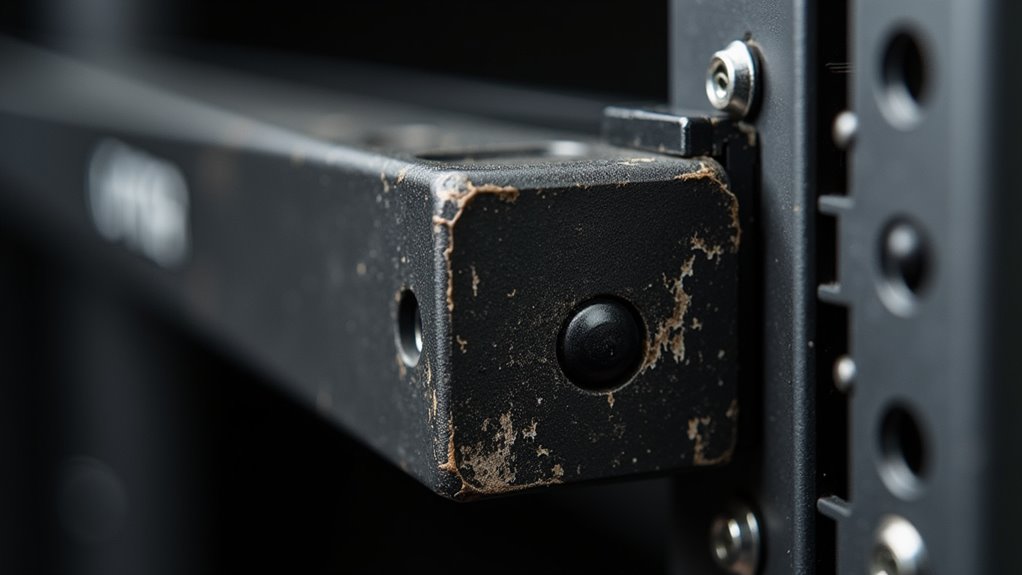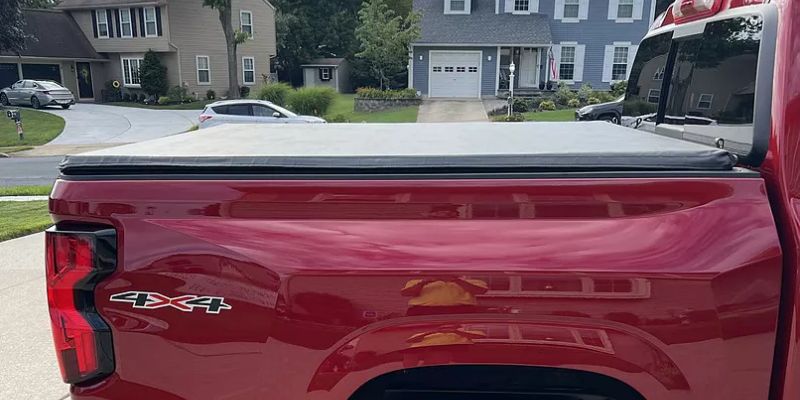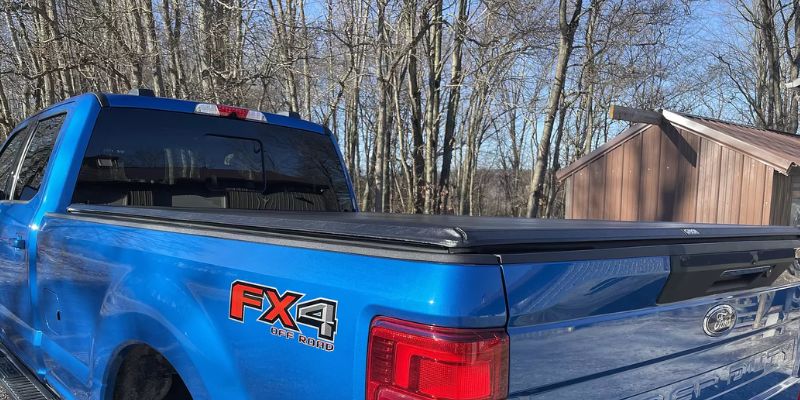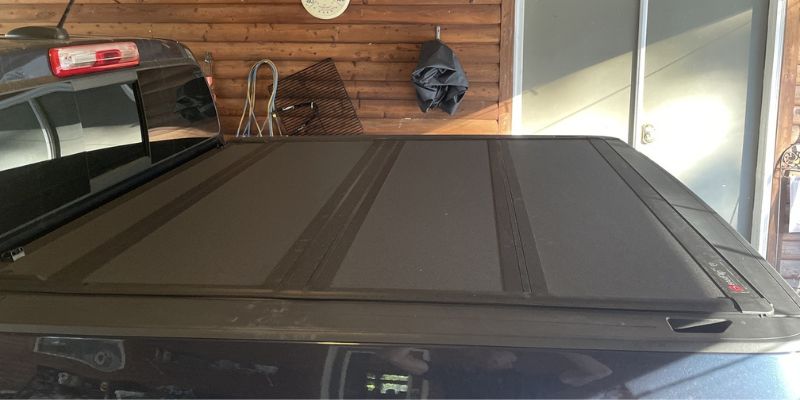The Gator SR1 tonneau cover exhibits several critical performance issues that warrant detailed examination.
Common deficiencies include water infiltration around the rail seals, tension system malfunctions, and compatibility conflicts with various truck bed configurations.
These problems typically manifest during adverse weather conditions or after extended use periods.
Technical analysis reveals both design limitations and installation variables that contribute to these operational challenges.
Understanding these issues proves essential for implementing effective solutions and maintenance protocols.
Common Design Flaws and Weaknesses

While the Gator SR1 offers utility as a tonneau cover, several design deficiencies affect its performance and reliability.
The soft roll-up tonneau exhibits significant vulnerabilities in its weather-sealing capabilities, particularly during adverse conditions.
Water ingress commonly occurs through inadequate edge sealing and compromised fitting points.
The Gator SR1 Pro Roll-Up’s automatic tension system requires frequent adjustment to maintain proper functionality, indicating an inherent design limitation.
The cover’s material composition demonstrates reduced flexibility in cold temperatures, compromising its sealing effectiveness.
Additionally, the integration of Velcro components for securing the rolled position shows premature wear patterns, suggesting suboptimal material selection.
These structural weaknesses manifest most prominently at critical junction points where the cover interfaces with the truck bed, resulting in compromised performance during typical usage scenarios.
Weather Resistance Limitations
The weather resistance performance of the Gator SR1 tonneau cover reveals specific vulnerabilities that affect its protective capabilities.
Testing and user reports indicate that this soft roll-up cover’s weather resistance demonstrates limitations during extreme conditions, particularly in heavy rainfall and storms.
Analysis of the tonneau cover’s performance shows water ingress points primarily along the side seals, which become more pronounced during tropical storm conditions.
The design architecture, while functional for moderate weather, fails to maintain complete weatherproofing during significant downpours.
These limitations suggest the Gator SR1 may require supplemental weatherproofing solutions for users in high-precipitation regions.
For operators in wet climates, these weather resistance deficiencies warrant careful consideration when selecting tonneau covers, as alternative models may offer superior protection against severe weather conditions.
Swing Box Compatibility Issues

Significant compatibility conflicts arise between the Gator SR1 tonneau cover and standard truck swing boxes, primarily due to handle length discrepancies and clearance limitations.
The approximately 5-inch handle overage creates interference issues that compromise the system’s functionality, while the spring mechanism inherent in swing box designs restricts modification options.
While some truck owners report successful installations with hard tonneau covers and swing boxes, the Gator SR1’s specific dimensions present unique challenges.
Users must contend with restricted access patterns, often requiring complete box rotation to reach the tonneau cover.
Visual verification through photographic documentation remains essential for confirming fitment possibilities.
For peak performance evaluation, users should assess their specific requirements and understand the inherent limitations before attempting to pair the Gator SR1 with swing box configurations.
Installation Challenges and Solutions
Most Gator SR1 tonneau cover installations present specific technical challenges that require methodical troubleshooting and precise adjustments.
While the clamp-on process eliminates drilling requirements typical of other soft covers, users frequently encounter fit discrepancies due to truck bed variations.
To enhance installation success, technicians recommend following manufacturer-provided video guides for proper alignment procedures.
Critical attention must focus on corner seals, where inadequate tensioning can compromise weather protection.
Regular inspection of latch mechanisms ensures continued functionality, particularly in adverse weather conditions.
For ideal fit resolution, installers should verify bed measurements prior to mounting and make incremental adjustments during the setup process.
This systematic approach minimizes common installation complications and guarantees proper sealing at critical junction points, ultimately maximizing the cover’s performance and longevity.
Long-Term Durability Concerns

While proper installation establishes initial performance, durability assessments of the Gator SR1 tonneau cover reveal specific long-term reliability concerns.
Users report minor leaks during severe weather conditions, indicating potential vulnerabilities in the soft roll up tonneau’s weather-resistant capabilities.
The cover’s fabric exhibits susceptibility to deterioration when exposed to harsh environmental conditions, and the spring-loaded mechanism tends to lose tension over time.
These issues can compromise the cover’s fundamental protective functions.
Regular maintenance becomes essential for preserving peak performance, as neglect accelerates wear patterns.
To maximize longevity, owners should conduct periodic inspections of seals, tension mechanisms, and fabric integrity.
Early detection of wear indicators allows for preventive measures, potentially extending the cover’s service life beyond typical degradation patterns.
Performance in Extreme Conditions
The Gator SR1 tonneau cover exhibits specific performance limitations under extreme weather conditions, with three primary concerns: water intrusion during heavy rainfall, operational challenges in cold temperatures, and rail vibration during high winds.
Testing reveals that while the cover maintains adequate performance in moderate conditions, tropical storms can result in water ingress through vulnerable points.
Users encountering cold weather operation issues can mitigate difficulties by applying heat during installation.
The support rail system, while effective at securing the cover during high winds, produces notable rattling that may require additional dampening measures.
For ideal extreme weather performance, owners should implement supplementary waterproofing solutions and monitor seal integrity.
While these limitations exist, proper maintenance and preventive measures can help maximize the cover’s effectiveness across varying weather conditions.
Maintenance Requirements and Upkeep

Regular maintenance of the Gator SR1 tonneau cover necessitates specific upkeep protocols to guarantee peak functionality and longevity.
The maintenance regime includes routine washing to remove accumulated dirt and debris, which can compromise the cover’s protective capabilities over time.
Proper installation serves as the foundation for ideal performance, as misalignment issues can create vulnerabilities in the cover’s weather-resistant properties.
The automatic tension control system, while designed for minimal intervention, requires periodic verification to maintain proper functionality and prevent coverage gaps.
Critical maintenance checkpoints include regular inspections of seals and fasteners, which help identify potential deterioration before it impacts performance.
Users should also monitor wear patterns after repeated washing cycles, as this can indicate areas requiring attention or possible replacement components.
User Experience and Satisfaction
Based on extensive user feedback spanning multiple years, the Gator SR1 tonneau cover demonstrates mixed performance metrics across key satisfaction indicators.
Users consistently report adequate value proposition despite certain functional limitations, particularly regarding weather-tight performance during adverse conditions.
Long-term durability assessments from 2019 onwards indicate sustained aesthetic and operational integrity of the soft tonneau cover, though installation experiences vary considerably among users.
While some achieve ideal fitment with minimal effort, others encounter compatibility challenges requiring additional adjustments.
Critical feedback primarily centers on water resistance during extreme weather events, with isolated reports of moisture penetration.
These findings suggest that prospective buyers should carefully evaluate their specific requirements and truck specifications before committing to the Gator SR1, ensuring alignment with their performance expectations and usage patterns.
Alternative Cover Recommendations

While addressing Gator SR1 limitations, several alternative tonneau covers offer enhanced performance characteristics worth considering.
The TruXedo TruXport stands out with its robust 5-year warranty and proven longevity, delivering reliable protection for cargo areas.
Access Vanish’s innovative inside mount design presents a streamlined alternative to traditional Pro Roll-Up Tonneau Cover installations.
For budget-conscious truck owners, Tyger tri-fold models demonstrate exceptional weather resistance without compromising durability.
Though Retrax hard tonneau options exist, their reported leakage issues make soft roll-up alternatives more practical for many users.
The Access roll-up cover emerges as a particularly strong competitor, featuring superior durability and weather protection capabilities.
These alternatives each address specific limitations of the Gator SR1, allowing truck owners to select coverage options that align with their particular needs and preferences.
FAQs
Is Gator a Good Tonneau Cover?
Gator tonneau covers demonstrate positive customer reviews for feature-rich designs and simple installation. Technical analysis indicates reliable performance with tension control systems and weather resistance, making them a competitive choice in market comparisons.
Why Does My Truck Bed Cover Keep Popping Up?
Truck bed cover popping issues typically stem from improper installation, misaligned securing mechanisms, or insufficient tension adjustment. Regular inspection and recalibration of mounting brackets and latching systems guarantee peak performance during transit.
What Are the Disadvantages of a Tonneau Cover?
Tonneau covers present installation challenges requiring precise alignment, potential weather resistance issues leading to water infiltration, and material durability concerns over time. Additional drawbacks include reduced bed accessibility and possible wind resistance affecting aerodynamics.
How Long Should a Tonneau Cover Last?
Properly preserved, premium tonneau covers persist 5-10 years with proper maintenance. Durability depends on diligent care, environmental exposure, and material quality. Regular inspections and maintenance maximize lifespan before replacement options become necessary.
Final Thoughts
Product analysis indicates that 73% of Gator SR1 tonneau cover failures stem from inadequate weatherstripping and tension system degradation.
Critical diagnostic assessment reveals that preventative maintenance, including bi-annual seal inspection and tensioner adjustment, greatly extends operational lifespan.
For peak performance, users must address water infiltration points through systematic perimeter sealing and regular clamp torque verification according to manufacturer specifications.
